Hello readers! Have you ever thought about adding something warm, handmade, and truly unique to your office walls? That’s where Sikki grass wall hangings step in.
Made from golden-hued natural grass, these artworks are not just pretty decorations but also carry a sense of tradition and craftsmanship. They bring nature indoors, brighten up dull corners, and give workspaces a calm, refreshing vibe.
In today’s world of glass and concrete, a touch of eco-friendly art can make all the difference. Let’s explore how these simple yet stunning wall hangings can transform offices into inspiring spaces.
History of Sikki Grass Craft
- Origin in Bihar: Sikki grass craft is centuries old, rooted in the Mithila and Madhubani regions of Bihar.
- Everyday Use: In earlier times, Sikki was not used for wall hangings. Instead, it was woven into baskets, boxes, and storage containers for daily life.
- Golden Hue Charm: The natural golden color of Sikki grass gave these items both beauty and functionality, making them a part of every rural household.
🧵 Traditional Crafting by Women
- Women as Custodians: Traditionally, it was village women who harvested, dyed, and hand-braided the grass.
- Community Activity: Making Sikki objects was often a social task, where women sat together and wove while exchanging stories.
- Gift Culture: Crafted objects were offered as wedding gifts, festive presents, and symbols of love and blessings.
🎨 Shift Towards Artistic Expression
- Beyond Utility: With time, artisans realized the potential of Sikki grass for creating decorative pieces, not just utility items.
- Integration with Folk Art: Sikki craft often borrowed motifs from Madhubani paintings, such as fish, birds, and floral patterns.
- From Basket to Canvas: Slowly, artisans began weaving grass into flat, framed designs suitable for walls.
🏙️ Entry into Urban Spaces
- Handmade Heritage in Cities: As urban buyers developed interest in eco-friendly décor, Sikki wall hangings found their way into homes and offices.
- Craft Fairs and Exhibitions: Government and NGOs played a role by bringing Sikki artisans to trade fairs and handicraft expos.
- Cultural Shift: What was once village storage now became urban wall art, carrying rural stories into modern living rooms and office corridors.
🌍 Contemporary Relevance
- Eco-Friendly Appeal: Today, when sustainability is a lifestyle, Sikki wall hangings fit perfectly into eco-conscious office décor.
- Global Recognition: Designers and exporters now promote Sikki craft not just in India, but across global markets.
- Preserving Heritage: Each wall hanging in a modern office is more than decoration—it’s a bridge between traditional roots and contemporary design.
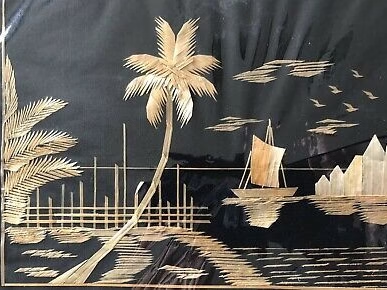
🌿 Material Used and Steps of Making
Sikki grass craft is one of India’s most charming traditional arts, often admired for its golden sheen and delicate patterns.
When transformed into wall hangings, it not only decorates homes but also adds a warm, earthy vibe to modern office spaces. Let’s dive into the materials and the steps of making these beautiful creations.
Materials Used in Sikki Grass Wall Hangings
- Sikki Grass
- The star of the craft, this natural golden-hued grass grows in marshy and wetland areas, especially in Bihar.
- Its shiny surface makes it look naturally polished without needing any artificial coating.
- The star of the craft, this natural golden-hued grass grows in marshy and wetland areas, especially in Bihar.
- Takua (Crafting Needle)
- A small iron tool with a wooden handle, used to stitch, twist, and shape the grass into designs.
- Acts as the artisan’s brush, giving life to motifs.
- A small iron tool with a wooden handle, used to stitch, twist, and shape the grass into designs.
- Munji Grass (Binding Grass)
- A stronger variety of grass used as the base or frame material.
- Provides support and strength to the delicate Sikki strands.
- A stronger variety of grass used as the base or frame material.
- Threads and Natural Dyes
- Cotton threads are used for binding.
- Sometimes natural dyes are applied to add vibrant touches, though most artisans prefer the raw golden look.
- Cotton threads are used for binding.
- Supporting Base
- For wall hangings, a backing of cloth, cardboard, or bamboo strips is used so that the design stays firm and hangs easily.
- For wall hangings, a backing of cloth, cardboard, or bamboo strips is used so that the design stays firm and hangs easily.
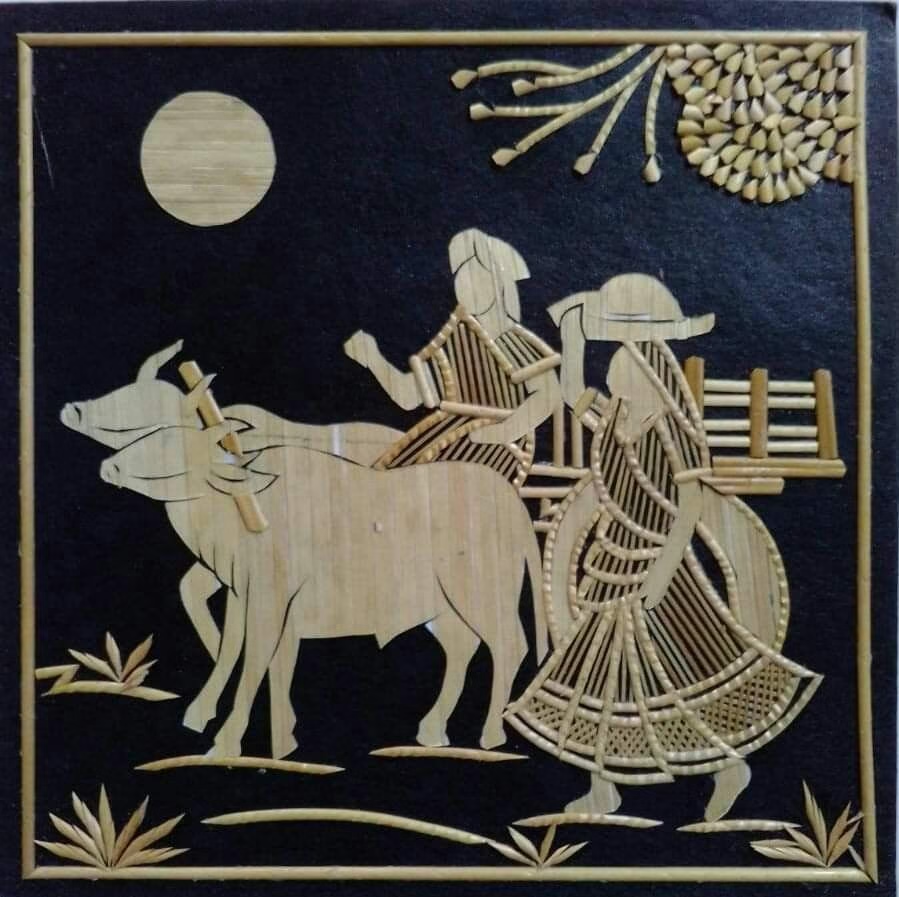
Steps of Making Sikki Grass Wall Hangings
🌱 Step 1: Collecting the Grass
- Harvested mainly from riverbanks and marshlands.
- Grass is carefully picked during specific seasons when it is soft and shiny.
- Artisans usually select only the fine stalks for crafting.
🌞 Step 2: Drying and Preparation
- Freshly collected grass is sun-dried to remove moisture.
- The flower tops are trimmed off, leaving only the clean, golden stalks.
- This process enhances the natural sheen and durability.
✂️ Step 3: Splitting and Softening
- Grass strands are split into thin pieces using fingers or simple knives.
- To make them flexible, they are kept slightly damp or sometimes steamed.
- This ensures they don’t break while bending into shapes.
🪡 Step 4: Creating the Base Structure
- A framework is made using Munji grass or bamboo strips.
- This base gives the wall hanging its shape—circular, rectangular, or sometimes intricate motifs like trees or mandalas.
🎨 Step 5: Weaving and Shaping with Takua
- Using the Takua needle, artisans twist and coil Sikki strands around the base.
- Designs such as flowers, birds, geometric borders, or deities are woven in.
- Each coil is carefully tightened so the motif appears neat and raised.
🌺 Step 6: Adding Motifs and Detailing
- Popular motifs include lotuses, peacocks, elephants, and traditional tribal patterns.
- Borders are often decorated with zig-zag or spiral designs for extra elegance.
- Some pieces are left natural, while others are highlighted with colored grass.
🧵 Step 7: Binding and Finishing Touches
- Loose ends are tied with cotton threads for strength.
- If required, natural dyes are added to give contrast shades.
- The finished piece is carefully trimmed and polished by hand.
🖼️ Step 8: Mounting for Office Décor
- Finally, the wall hanging is fixed onto a sturdy backing—cloth, cardboard, or bamboo.
- Loops or hooks are added so it can be hung easily in office spaces.
- The result is a unique décor piece that blends heritage with modern interiors.
Symbols and Motifs
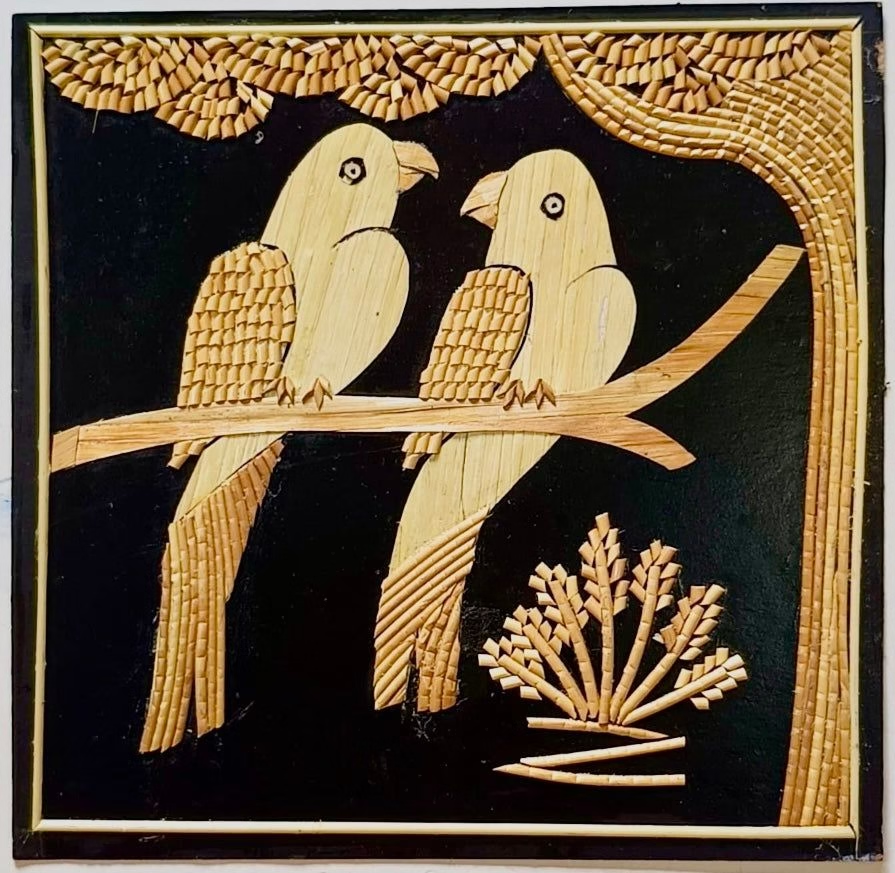
When you see a Sikki grass wall hanging, it’s not just a pretty craft made of golden grass—it’s a woven story. Each curve, knot, and pattern has meaning.
In offices, these motifs don’t just brighten walls; they also carry cultural depth, positive energy, and symbolism that make the workspace feel more human.
🌸 Nature-Inspired Motifs
Sikki grass craft often takes inspiration from the natural world, connecting modern office décor to age-old love for the environment.
- Floral Patterns
- Flowers symbolize growth, positivity, and renewal.
- Commonly seen as lotus, marigold, or generic blooms, they remind us of fresh beginnings.
- In offices, floral Sikki designs bring a sense of calmness and creativity.
- Flowers symbolize growth, positivity, and renewal.
- Leaf and Vine Motifs
- Represent continuity, harmony, and sustainability.
- Creeper-style motifs woven into wall hangings add flow and movement, balancing static office walls.
- They remind employees of resilience—how growth continues even in small steps.
- Represent continuity, harmony, and sustainability.
- Tree Designs
- Trees stand for strength, stability, and rootedness.
- Perfect for boardrooms or entry walls, they symbolize the company’s long-term vision.
- Trees stand for strength, stability, and rootedness.
🕊️ Animal and Bird Motifs
Many Sikki artisans weave stylized animals and birds, which carry symbolic meaning in workplaces.
- Elephant Motif
- Symbolizes wisdom, strength, and good fortune.
- A Sikki elephant wall hanging at the office entrance is believed to attract prosperity.
- Symbolizes wisdom, strength, and good fortune.
- Peacock Designs
- Represent beauty, pride, and cultural richness.
- Ideal for reception walls, where they create a striking first impression.
- Represent beauty, pride, and cultural richness.
- Fish Motifs
- Fish symbolize abundance and movement.
- They are considered auspicious in Indian art and can signify “flow” and “progress” in office settings.
- Fish symbolize abundance and movement.
🔺 Geometric Patterns and Abstract Symbols
Sikki craft often combines traditional symbolism with geometric simplicity, making it suitable for modern offices.
- Circular Motifs (Mandala Style)
- Represent unity, wholeness, and continuity.
- In offices, they inspire teamwork and interconnectedness.
- Represent unity, wholeness, and continuity.
- Diamond Shapes
- Stand for clarity, focus, and balance.
- Repeated diamond patterns in Sikki wall hangings add structure and rhythm to office interiors.
- Stand for clarity, focus, and balance.
- Chevron and Zigzag Patterns
- Express movement, energy, and growth.
- Perfect for creative spaces where innovation is encouraged.
- Express movement, energy, and growth.
🌺 Religious and Cultural Symbols
Some motifs carry traditional spiritual meanings but adapt beautifully into office décor.
- Lotus Motif
- A recurring theme in Sikki craft, the lotus represents purity, renewal, and enlightenment.
- In offices, it reflects clarity of thought and fresh ideas.
- A recurring theme in Sikki craft, the lotus represents purity, renewal, and enlightenment.
- Conch and Sun Designs
- The conch symbolizes prosperity and positivity, while the sun represents life and vitality.
- These motifs bring uplifting energy into workplace settings.
- The conch symbolizes prosperity and positivity, while the sun represents life and vitality.
- Temple-Inspired Patterns
- Drawn from ancient architecture, these motifs symbolize protection and stability.
- They subtly remind employees of strong foundations and values.
- Drawn from ancient architecture, these motifs symbolize protection and stability.
🎨 Contemporary Motifs for Modern Offices
Artisans today also experiment with new-age motifs to keep up with changing décor preferences.
- Abstract Spirals and Waves
- Represent creativity, innovation, and flow of ideas.
- Great for brainstorming corners or lounges in offices.
- Represent creativity, innovation, and flow of ideas.
- Minimalist Linear Designs
- Simple straight lines symbolize clarity and direction.
- Work well in corporate offices with a modern, sleek aesthetic.
- Simple straight lines symbolize clarity and direction.
- Customized Motifs (Logos or Icons)
- Some wall hangings now incorporate company logos or symbolic icons.
- This not only personalizes décor but also weaves heritage into corporate branding.
- Some wall hangings now incorporate company logos or symbolic icons.
Growth of Sikki Grass Wall Hangings in India
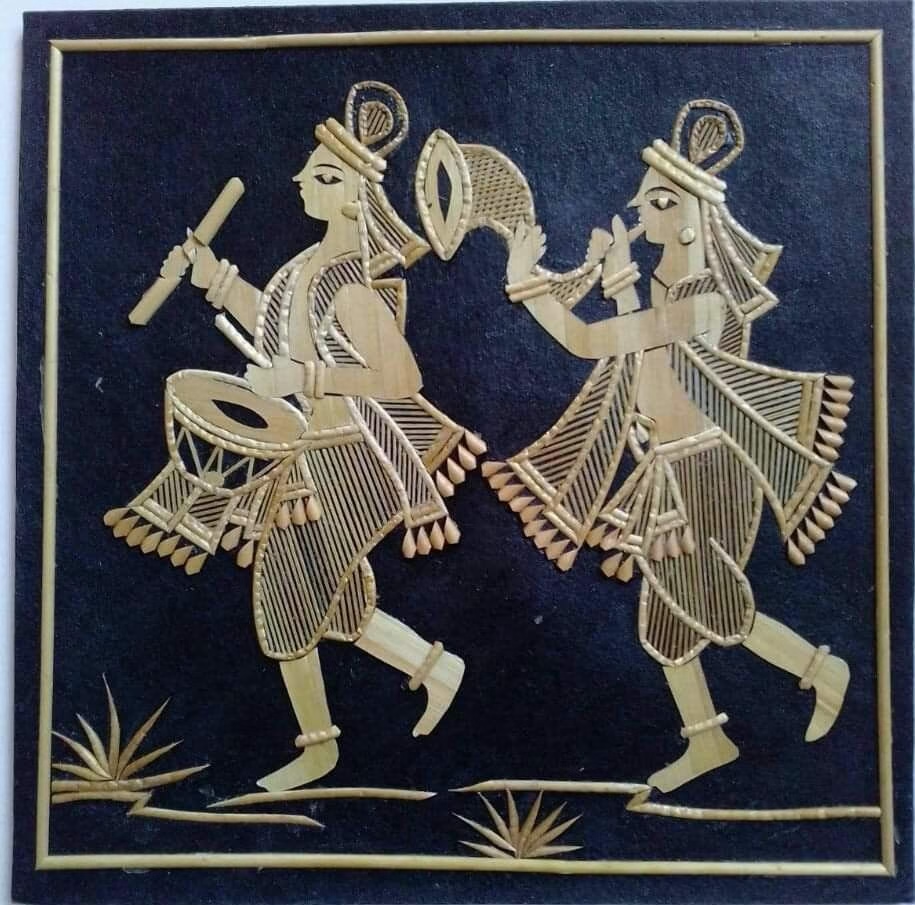
- Overall Market Size:
- The Indian handicraft industry was valued at USD 3.4 billion in 2022 and is expected to grow by around 8–10% annually.
- Sikki grass crafts, though a niche segment, are steadily gaining recognition under this growth.
- The Indian handicraft industry was valued at USD 3.4 billion in 2022 and is expected to grow by around 8–10% annually.
- Export Share:
- Handicrafts contribute significantly to exports, especially eco-friendly crafts.
- States like Bihar (the hub of Sikki craft) are now seeing artisans export smaller decorative items, including wall hangings, to countries like the USA, UK, and Japan.
- Handicrafts contribute significantly to exports, especially eco-friendly crafts.
🏢 Demand for Sustainable Office Décor
- Workplace Trends:
- Studies show that 65% of employees feel more positive and motivated in eco-friendly and aesthetically pleasing workspaces.
- Offices are shifting towards sustainable décor materials, and Sikki grass, being biodegradable and lightweight, fits perfectly.
- Studies show that 65% of employees feel more positive and motivated in eco-friendly and aesthetically pleasing workspaces.
- Corporate Interest:
- Over 40% of urban offices in India are now integrating natural décor items such as bamboo lamps, jute furniture, and Sikki grass wall art.
- Interior design firms report a rising interest in using handmade crafts for lobbies, meeting rooms, and creative corners.
- Over 40% of urban offices in India are now integrating natural décor items such as bamboo lamps, jute furniture, and Sikki grass wall art.
📈 Artisan Community and Employment Numbers
- Craft Cluster in Bihar:
- Around 10,000+ artisans in Bihar are directly or indirectly involved in Sikki grass weaving.
- Wall hangings have become one of the most in-demand products, creating seasonal employment opportunities.
- Around 10,000+ artisans in Bihar are directly or indirectly involved in Sikki grass weaving.
- Women Empowerment:
- Nearly 80% of Sikki grass artisans are women, making this craft not just an art form but also a livelihood for rural households.
- Nearly 80% of Sikki grass artisans are women, making this craft not just an art form but also a livelihood for rural households.
🌍 Consumer Behavior and Online Sales
- E-commerce Platforms:
- Platforms like Amazon Karigar, Craftsvilla, and state handicraft portals report an annual growth of 20–25% in sales of eco-friendly wall décor.
- Sikki wall hangings are among the most searched handicraft categories for office décor.
- Platforms like Amazon Karigar, Craftsvilla, and state handicraft portals report an annual growth of 20–25% in sales of eco-friendly wall décor.
- Urban Buyers:
- Young professionals and startups show the highest interest, with over 55% of sales coming from metro cities like Delhi, Bengaluru, and Mumbai.
How to Protect Sikki Grass Wall Hangings from Dust and Insects
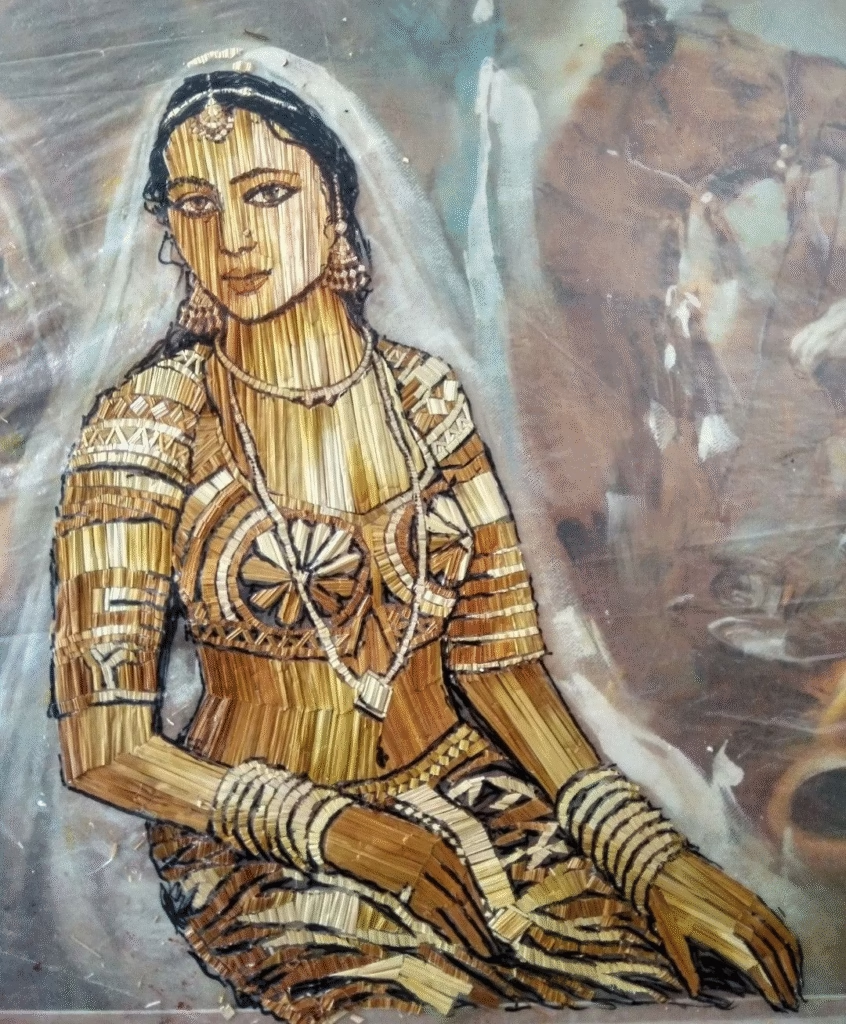
🧹 Regular Cleaning
- Dry Dusting: Use a soft, dry cloth or a feather duster once a week to gently remove surface dust.
- Vacuum Care: A handheld vacuum with a soft brush attachment can clean deep corners without harming the weave.
🌬️ Proper Ventilation
- Air Circulation: Hang the wall art in a place with good airflow to prevent moisture buildup, as dampness can attract insects.
- Avoid Damp Walls: Never place Sikki grass hangings against walls that are wet or prone to seepage.
🌞 Sunlight Exposure
- Natural Sun Care: Expose the wall hanging to mild sunlight (not harsh midday sun) for a couple of hours every few months. This helps kill hidden insects and keeps the grass dry.
🛡️ Insect Protection
- Natural Repellents: Place neem leaves, cloves, or camphor tablets nearby. Their smell naturally drives away insects without chemicals.
- Storage Safety: If storing, wrap the piece in breathable cotton cloth with neem leaves tucked inside.
🚫 Avoid Chemicals
- No Harsh Sprays: Avoid chemical cleaners or insecticides, as they may damage the natural shine of Sikki grass.
Wrapping-Up
So, folks, Sikki grass wall hangings are more than just decorative pieces; they are living expressions of India’s artistic heritage woven into golden strands of nature.
What makes them truly special is their ability to bring warmth, texture, and cultural depth into modern office spaces that often feel cold or mechanical.
By combining eco-friendly materials with age-old techniques, these crafts not only support rural artisans but also inspire sustainability in our lifestyles.
Also Read:- Pipli Appliqué Lampshades for Modern Living Rooms

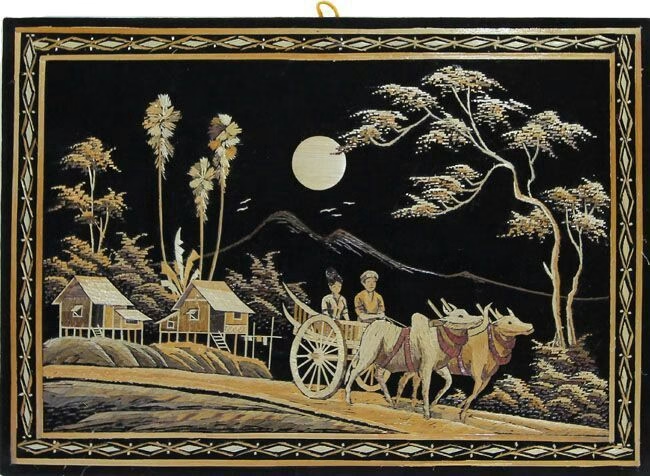
Leave a Reply